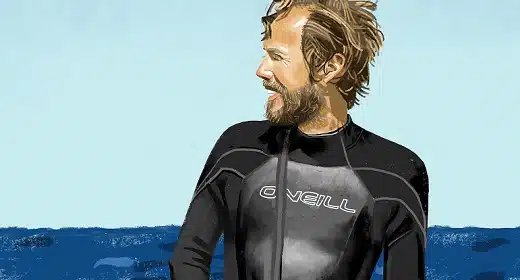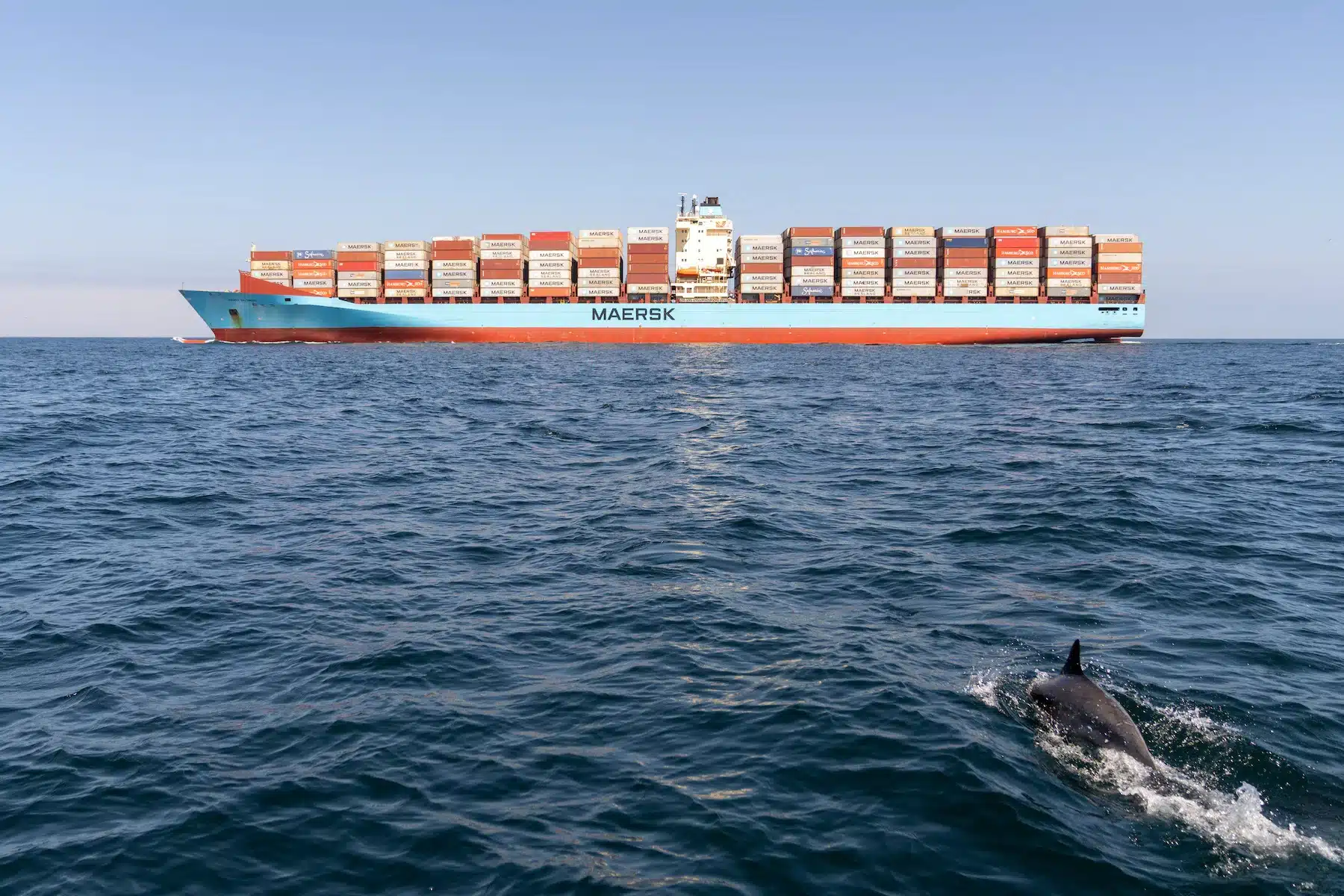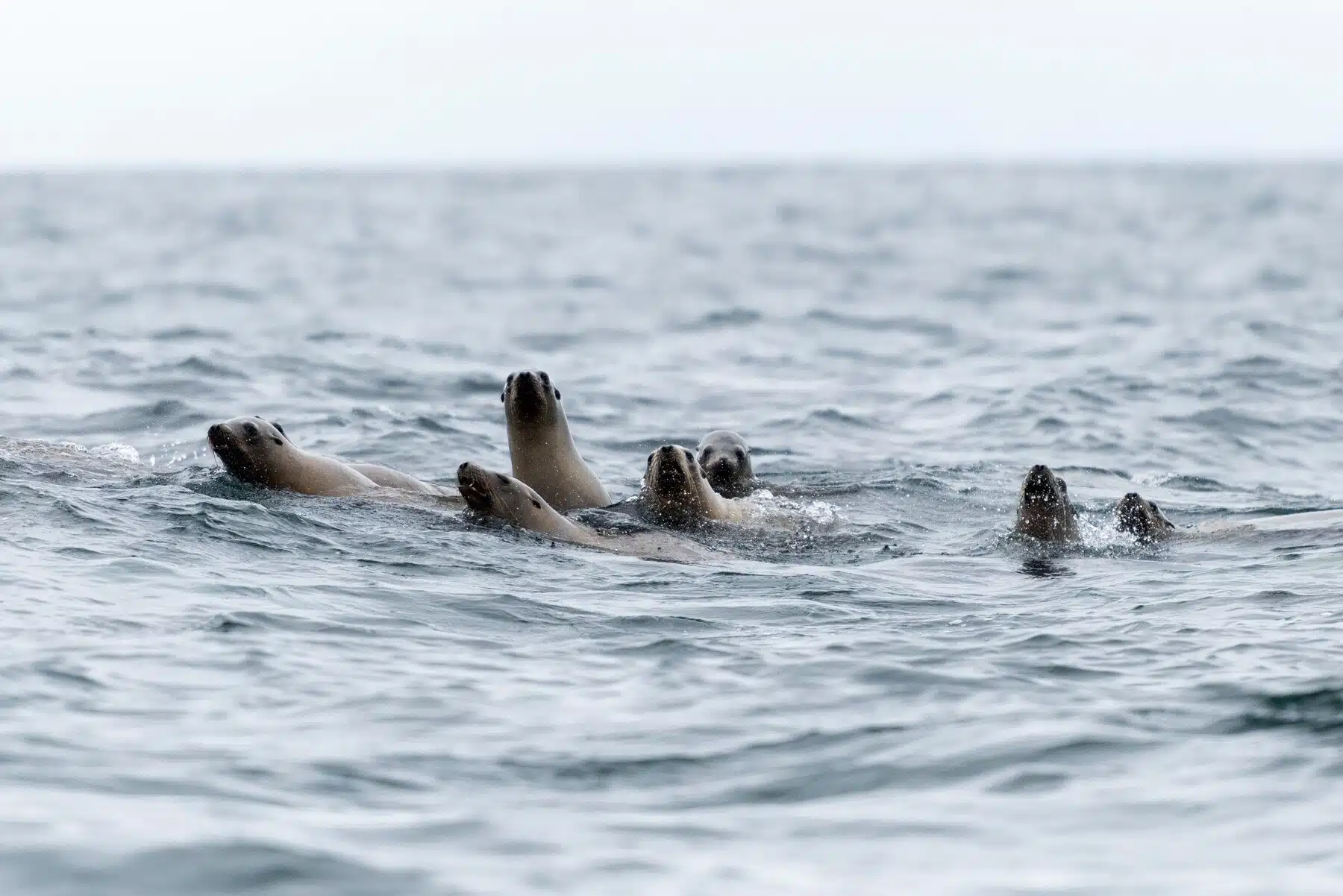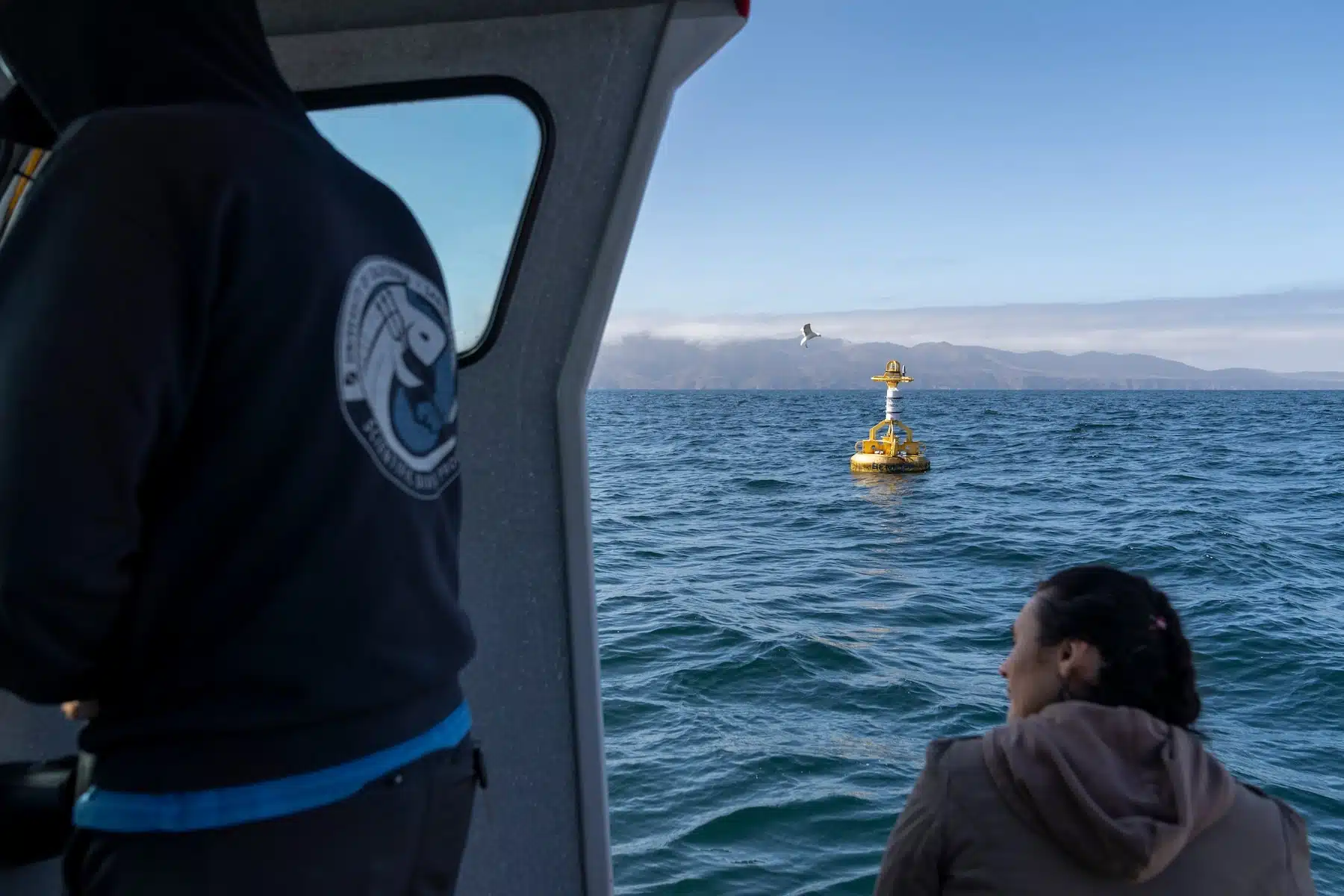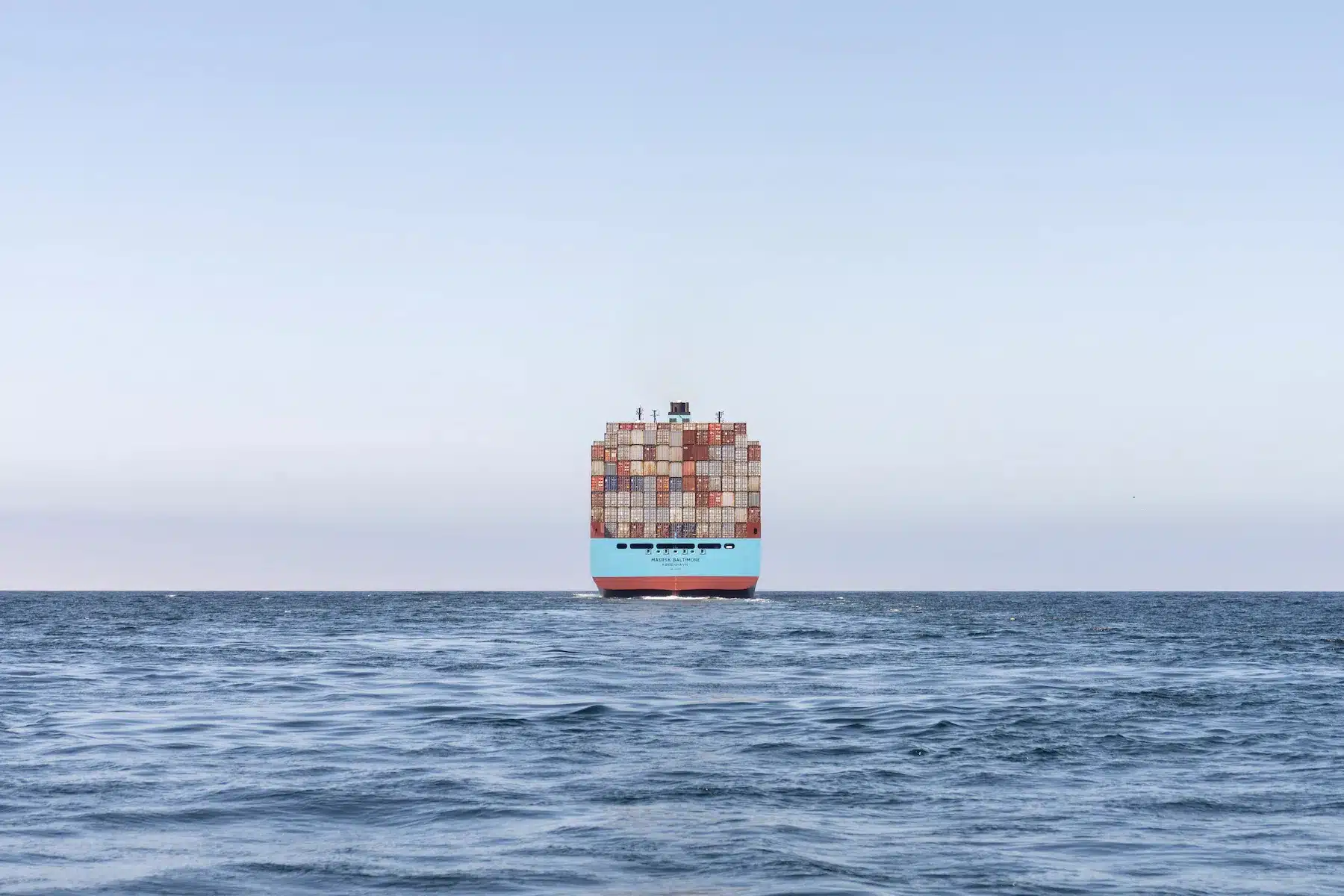Ocean scientist Douglas McCauley is trying to avoid the worst impacts of industrialization, by using data to reveal to companies, policymakers and the public what’s at stake…
Just yards from the Fish 1, a 22-foot research vessel, a humpback whale about twice the size of the boat hurled itself out of the water, sending shimmering droplets in a broken necklace of splash.
In the other direction, a hulking cargo ship, stacked high with containers, crept closer.
Aboard the Fish 1, a slight figure whose face is crinkled from years in the sun and saltwater, looked from one to the other. Ocean scientist Douglas McCauley wanted to see whether the near real-time detection system he and his colleagues had developed, Whale Safe, could avert collisions between whales and ships in the Santa Barbara Channel.
The tool represents one of the ways McCauley, who heads the Benioff Ocean Science Laboratory at the University of California Santa Barbara, is working to protect the ocean even as it becomes more industrialized. By collecting data from several sources — an acoustic monitoring buoy that listens for whale songs, identifies them according to species with an algorithm and sends that information to satellites; a predictive habitat model for blue whales; and sightings logged in an app — Whale Safe forecasts to ships the chances of meeting a whale. Then, it grades shipping companies on whether they actually slow down to 10 knots or less during whale migrations, from May 1 to Dec. 15.
“We can literally watch all of the ships in California and across the whole ocean; we are better positioned than ever before to try to track damage as it occurs, or before it occurs,” McCauley said a few days later in a Zoom call from the French Polynesian island of Moorea, where he is spending a month researching coral reefs. “We are in trouble if we don’t do something different, and I realized that if I kept sticking my head literally underwater or stayed in the lab, these problems weren’t going to fix themselves.”
Humans have worked in the seas for centuries: fishing, seafaring and more recently, drilling for oil and gas and the development of offshore wind farms. Shipping lanes cross almost every surface of the sea, except for shrinking swaths of the Southern and Arctic Ocean.
But as development has intensified and the planet has warmed, the 43-year-old McCauley has ventured into the gray area between scientific research and advocacy to try to fix these problems — or at least make them visible.
He is trying to save the whales; collect plastic; explore the links between climate change, overfishing and nutrition in the South Pacific; warn about the dangers of seabed mining; track sharks using drones and artificial intelligence; and calculate the benefits to people, animals and the planet that come from protecting broad swaths of the sea.
“One of Doug’s compelling traits as a scientist is that he is keen to explore outside the box,” said Benjamin Halpern, a UCSB professor of marine biology and ocean conservation who has worked with McCauley for about a decade. “He is a very creative thinker, and able to think differently about the solutions to problems and what kinds of research and science can help inform those.”
In meetings with corporate executives and political leaders, McCauley has made a consistent argument: Protecting the sea is in our interest, since it already does a lot of the work for us.
In 2020 McCauley led a report that provided a framework for marine protected areas on the high seas, finding that such refuges could be powerful tools for biodiversity conservation, carbon sequestration and climate resilience. Even port and fishing communities, he argued, depend on an ocean that is still wild and alive.
“We have a globally unique chance to talk about this before it’s too late,” he said.
California sea lions swim near the Channel Islands in California on Sept. 30. Humpback whales swim near the Channel Islands. Ship strikes killed 80 whales annually in three of the past four years, but the toll is probably much higher than reported. Dolphins swim near the Channel Islands in California.
The encounter in late September, amid one of the world’s busiest shipping channels and a vibrant ecosystem, offered a glimpse of how to do just that. Minutes after the container ship had passed McCauley’s boat, the whale — possibly the same one, but it is hard to tell — had found another, and the two sent up exhales of spray.
It was as if a bulldozer operator had plowed through a herd of elephants without stopping, not too far from a major city’s downtown, hoping to avoid a crash. And it happens many times a day here in the Santa Barbara Channel, even though barely anyone sees it.
While McCauley tracks these interactions, much of the public seems to have noticed this industrial shift underwater.
Since 2000, global container port traffic has nearly quadrupled; aquaculture produces more than half of the fish we eat; about 8 million metric tons of plastic enter the oceans every year; over half the global oceans are fished; more than 700,000 miles of undersea data cables snake across the ocean floor; seabed mining may soon begin in some of the world’s last pristine ecosystems; and the fishing industry is beginning to target deep ocean life.

The ocean is, by far, the world’s largest carbon sink, having absorbed about 40 percent of the excess greenhouse gasses from burning fossil fuels. But it comes at a cost: more acidic and warmer waters, which may not soak up as much carbon going forward. The fact that ocean animals evolved to a narrow range of conditions, McCauley and others found, makes them more vulnerable to climate change.
The landscape was less crowded when McCauley grew up in Lomita, Calif., and went to school in San Pedro, not far from the ports and the channel. He could see whale migrations out the window of his high school geometry class. From an early age, he would ride his bike to the beach as an escape, and “all of a sudden, I was in a super wild place.”
He spent much of his adolescence and early adulthood working at the local public aquarium, and working on fishing boats.
It was there, catching squid at 1 a.m. to sell as bait, hauling in a croaker bigger than he was, and watching people spend $20 a day to go out a boat to catch dinner for their families, that he saw how a thriving ocean economy works.
It was later, in his career as a scientist, that he had data to explain what he learned through experience: What is good for the ocean is also good for people, and possibly business too. Slowing down ships means fewer ship strikes, which means more whales. That is good for biodiversity and climate change: Whales themselves are carbon sinks and fertilize plant growth (another carbon sink). It also means cleaner air for those who live nearby, and fewer carbon emissions from fossil fuels.
He spent much of his adolescence and early adulthood working at the local public aquarium, and working on fishing boats.
It was there, catching squid at 1 a.m. to sell as bait, hauling in a croaker bigger than he was, and watching people spend $20 a day to go out a boat to catch dinner for their families, that he saw how a thriving ocean economy works.
It was later, in his career as a scientist, that he had data to explain what he learned through experience: What is good for the ocean is also good for people, and possibly business too. Slowing down ships means fewer ship strikes, which means more whales. That is good for biodiversity and climate change: Whales themselves are carbon sinks and fertilize plant growth (another carbon sink). It also means cleaner air for those who live nearby, and fewer carbon emissions from fossil fuels.
Lee Kindberg, the head of environment and sustainability for Maersk, which received a B for slowing down in about 79 percent of cases, said the company supports Whale Safe. But she added that shippers must balance safety and speed restrictions against weather and demands from companies — and their customers — who want everything faster.
And, as climate change scrambles whales’ migration patterns and schedules, tools like Whale Safe may become even more essential in protecting them, McCauley said.
Trying to prevent ship strikes, one of the leading causes of whale deaths, is becoming an emergency. Three of the past four years rank as the deadliest on record for whales on the West Coast — about 80 annually — but the death toll is probably much higher, since most sink to the ocean floor. There have been no known ship strikes in the Santa Barbara Channel since the launch of Whale Safe in 2020, though it is too early to make a causal link.
While aboard the Fish 1, McCauley pulled on a wet suit, flippers and a mask and jumped into the water to inspect the buoy. Looking not unlike one of the sea lions who popped up nearby with his slick outer layer and whiskers poking out beneath his mask, he scrubbed it for barnacles, and made sure all of the hardware was in good condition.
Like the buoys, McCauley seems to be able to take in information, translate it into languages its recipients understand and make it actionable, according to Jane Lubchenco, a marine ecologist who has worked with McCauley and now serves as deputy director for climate and environment at the White House Office of Science and Technology Policy.
“He is adept at boiling something down to the most important components and expressing his knowledge in an accessible fashion, and he is passionate about solutions,” she said in an email.
CLIMATE SOLUTIONS VISIONARIES
HAND-CURATED
Still, some worry that engaging with industry could allow companies to burnish their image.
“Doug does seem quite nimble and effective at engaging with the private sector, and I don’t know if that’s a good or a bad thing,” Halpern said. “Maybe it’s valuable that someone is testing those waters, because we can’t solve the climate change catastrophe we face without engaging the private sector and corporations.”
McCauley spreads his message with a billionaire’s help. Salesforce co-founder Marc Benioff and his wife Lynne decided to fund an ocean science lab after reading a landmark study he co-authored on the ocean’s industrialization. McCauley serves as the lab’s director, and the university has received $88 million from the Benioffs since 2016.
Since then, their conversations about the ocean and “carbon math” have shaped much of Benioff’s climate and environmental philanthropy, including the “Trillion Trees” tree-planting initiative. “By aligning with Doug on the ocean, we found a bigger vision on the climate,” Benioff said in a Zoom interview.
McCauley said he is aware that some might question engaging with private philanthropists and industry, but argued that he and others could not afford to wait for federal funding — and action. “We don’t have the luxury of time.”
Over the past few years, McCauley has tried to make that decision-enabling data available and legible to policymakers across the globe.
Alongside a group of other scientists, McCauley has worked in Kiribati to document how damage to coral reefs from climate change and overfishing harms the diet and health of country’s inhabitants, who depend on fish for essential nutrients. The researchers share that data with government officials to show which islands are most at risk.
McCauley is also tackling the issue of deep seabed mining, which could begin in international waters as soon as next year. McCauley and the Benioff Ocean Science Lab have tried to map potential excavation sites across the globe, since the public remains largely unaware of this development, its scope and its possible threats.
At the bottom of the ocean around the world lie significant deposits of metals, including some needed for electric vehicle batteries and other clean energy projects. Some companies see ocean deposits as key to this clean energy transition, and are jockeying for primacy in this prospective new industry.
Along with more than 400 other scientists, McCauley signed a statement last year arguing that deep-sea mining will result in “loss of biodiversity and ecosystem functioning that would be irreversible on multigenerational time scales.” They argued that there are still too many unknowns in the deep ocean to mine them responsibly.
McCauley helped bring together leaders from environmental nonprofits and businesses to discuss the risks of seabed mining. Afterward, other advocates successfully worked to pressure Google, BMW, Volvo, Samsung and others to support a moratorium.
But industry officials such as the Metals Company CEO Gerard Barron counter that deep-sea mining opponents are ignoring the trade-offs that come from keeping the ocean off limits.
“While saying ‘No’ to something is easy,” said Barron, who heads a seabed mining corporation, “finding a solution is hard and if we fail to consider all our options, we will consign our biodiverse rainforests and carbon sinks to further destruction, increase our emissions load, and further damage the oceans Douglas has set out to protect.”
McCauley, by contrast, sees these planetary puzzle pieces as interlocked. Stopping seabed mining might mean less ocean noise, which might mean more whales, which means more stored carbon, which might mean fewer forest fires in his native California, or less sea-level rise in Kiribati.
Sometimes it is impossible for McCauley to ignore how climate change has changed his surroundings. He recently took a group of students to the woods near Santa Barbara to learn about the carbon cycle, but had difficulty teaching the lesson because almost all of the trees around them had died of drought, beetle infestation, or forest fire.
“I have too real a sense of how bad things are going to get with climate in such a short amount of time,” he said.
Still, he manages to marvel at the natural world, and the mysteries it holds.
Back aboard the Fish 1, not long after the container ship — and an oil tanker — had passed by, one of the whales came right underneath the boat. It surfaced briefly about 10 feet away, flicking its tail and disappearing.
Later, over Zoom, McCauley reflected on that moment: “I have no good explanation for why a whale would swim under the boat and look up at us, other than that it can.
“Some piece of that is a reminder that they deserve a space on the planet because they are incredibly intelligent, incredibly complex and sophisticated animals, and wonder about us as much as we wonder about them.”
Source: The Washington Post







